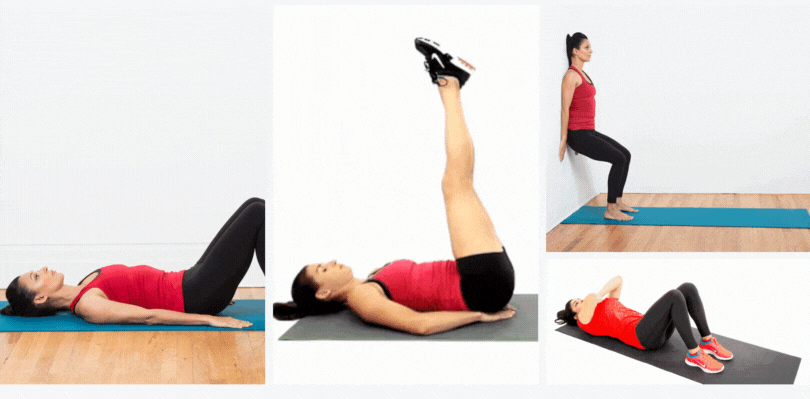Sciatica can be a very painful and debilitating condition, but with the right sciatica stretches and exercises, you can help reduce your pain and improve your mobility. Sciatica is a common condition that is caused by irritation or compression of the sciatic nerve, which is the biggest nerve in the body. It can cause pain, tingling, numbness, and weakness in the lower back, buttocks, and legs. While sciatica is usually caused by a herniated disc, it can also be caused by piriformis syndrome, spinal stenosis, and other conditions.
Fortunately, there are many different sciatica stretches and exercises that can help relieve the pain and discomfort associated with sciatica. In this blog post, we will discuss the benefits of sciatica stretches and exercises and provide a few tips for practicing them. We will also provide some exercises and yoga poses for sciatica that you can try at home.
What Are Sciatica Stretches
Sciatica is a type of nerve pain along the sciatic nerve. The sciatic nerve is the widest and longest nerve in the body and runs from the lower back through the buttocks and down into each leg. In some places, the nerve can be up to 2 cm in diameter.
When you have “sciatica,” you feel mild to severe pain anywhere along the line of your sciatic nerve, from your lower back to your hips, buttocks, and/or legs. It can also cause muscle weakness in the legs and feet, numbness in the legs, and uncomfortable tingling in the legs, feet, and toes.
In short, there are some spacer-like discs between each vertebra. When the sciatic nerve starts pinching out of where it’s supposed to be, which can happen when you twist or turn around to lift an object, it can cause a whole world of pain.
Stretches And Exercises You Can Do To Relieve Sciatica Pain
Straighten your left arm out in front of you and your right leg behind you. (You can do them at the same time or one after the other.) Make sure they are in line with your back. (Doing this next to a mirror makes checking your form easier.)
There are many stretches that can help relieve sciatica pain. At the same time, there are also some stretching routines that you should avoid. For example, exercises like deep squats or lunges will only worsen your pain. So what are the best stretches for sciatica?
Some yoga poses may also help relieve sciatica pain. However, note that suitable stretches for sciatica differ depending on the cause of sciatica. For example, there are specific stretching exercises that are almost always necessary to relieve piriformis syndrome and these differ from the stretches to ease sciatica caused by spinal stenosis.
Make Sure To Warm Up Before Starting Any Stretch Or Exercise
While it may need some extra pampering, don’t leave your feet on them for too long. Too much bed rest can weaken your muscles. When you’re feeling out of your usual workout, it’s wise to listen to your body’s signals. But try not to sit for too long, or the pain will worsen.
Remember: Before starting any exercise program, consult a doctor or physical therapist. By tailoring your workouts to your medical history and current condition, you can ensure that you are moving in a style that is sure to relieve your symptoms. (For example, some exercises may not be suitable for pregnant women or people with previous injuries.)
Exercises For Sciatica

One of the best ways to alleviate sciatic nerve pain is to perform specific exercises that target the affected area. Here are a few exercises that you can do at home to help reduce sciatica pain:
- Pelvic Tilts: Lie on your back with your knees bent. Slowly tilt your pelvis towards your chest, hold for a few seconds, then release. Repeat this exercise 10 times.
- Leg Lifts: Lie on your back with your knees bent. Slowly lift one leg up to the ceiling, hold for a few seconds, then lower it back down. Repeat this exercise 5-10 times for each leg.
- Heel Slides: Lie on your back with your knees bent. Slide one heel out, hold for a few seconds, then slide it back in. Repeat this exercise 5-10 times for each leg.
- Wall Sits: Stand with your back against a wall and slowly lower yourself into a seated position. Hold this position for 30 seconds, then stand back up. Repeat this exercise 5 times.
Yoga Poses For Sciatica
Yoga is a great way to relieve tension, improve flexibility, and reduce sciatic nerve pain. Here are a few yoga poses that you can do at home to help alleviate sciatica pain:
- Child’s Pose: Get into a kneeling position and sit back on your heels. Slowly lower your torso and rest your forehead on the ground. Hold this position for 30 seconds.
- Cat and Cow Pose: Get into a tabletop position on all fours. Slowly arch your back and drop your head towards the ground, then tilt your tailbone up and lift your head towards the ceiling. Repeat this pose 5 times.
- Downward Facing Dog: Stand on all fours and slowly lift your hips towards the ceiling. Straighten your legs and press your heels toward the ground. Hold this pose for 30 seconds.
Benefits Of Sciatica Stretches And Exercises
- Sciatica stretches and exercises can help relax the muscles in your lower back, buttocks, and legs, allowing for better blood flow and less tension. This can help reduce sciatic nerve pain and improve your overall mobility. Additionally, consistent stretching and exercise can help strengthen your core and back muscles, which can provide more support for your spine.
- Stretching and exercising can also help reduce inflammation and swelling, which can help reduce pain and discomfort. Plus, incorporating sciatica stretches and exercises into your daily routine can help improve your posture and reduce your risk of future sciatica flare-ups.
Tips For Practicing Sciatica
Remember, it is important to start slow and gradually increase the intensity of your stretches and exercises. And if you feel any pain or discomfort, make sure to stop and consult with your doctor or physical therapist. When performing sciatica stretches and exercises, it is important to remember a few key tips:
- Make sure to warm up before stretching or exercising.
- Listen to your body and stop if you feel any pain or discomfort.
- Focus on your breathing and try to relax your muscles.
- Start slowly and gradually increase the intensity of your stretches and exercises.
- Avoid any exercises that cause you pain or discomfort.
- Make sure to stretch both sides of your body, even if you are only feeling pain on one side.
- Make sure to cool down after stretching and exercising.
FAQs
Can exercise make sciatica worse?
While exercise can help reduce sciatica pain, it can also make your symptoms worse if you overdo it. Make sure to start slow and gradually increase the intensity of your stretches and exercises. If you start to experience more pain or discomfort, make sure to stop and consult with your doctor or physical therapist.
How often should I do sciatica stretches?
It is recommended to do sciatica stretches and exercises at least 3 times a week for best results. However, make sure to listen to your body and stop if you feel any pain or discomfort.
Can sciatica cause numbness in the legs?
Yes, sciatica can cause numbness and tingling in the legs, as well as pain and weakness. If you are experiencing these symptoms, make sure to consult with your doctor or physical therapist.

